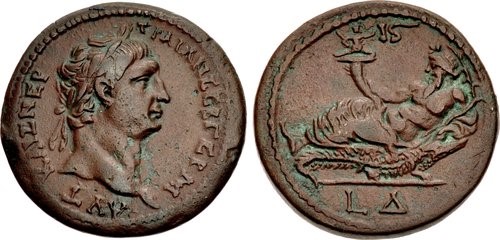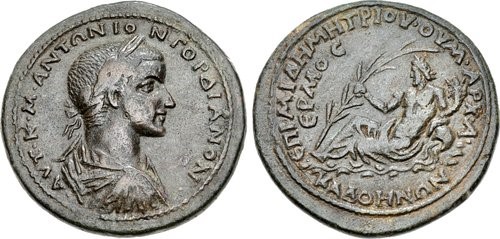NGC Ancients: River-Gods on Ancient Roman Coins
Posted on 5/11/2021
As we saw in the previous month’s column, the ancient Greeks portrayed river-gods on many different coins. That rich tradition continued under the Romans – not only on the coins they permitted local ‘Greek’ authorities to issue, but also on coins struck at imperial mints.
 |
The best place to start is with the silver tetradrachm above, issued at the city of Antioch in 5 B.C. for Rome’s first emperor, Augustus (27 B.C.-A.D. 14), who is portrayed on the obverse. A similar tetradrachm, also struck at Antioch with the same reverse type, but bearing the portrait of the Armenian King Tigranes II (95-56 B.C.), was illustrated in the previous column.
The reverse shows the river-god of the Orontes, a major river beside which Antioch was founded. The Orontes swims beneath the goddess Tyche, who represents Antioch.
 |
A typical depiction of a river-god on a Roman-era coin appears on the 20mm bronze above, issued c.A.D. 68-70 at Smyrna in Ionia. Nemesis stands opposite the reclining river-god, who holds a reed and rests upon an overturned vessel, from which water flows.
 |
 |
Shown above are two silver tetradrachms produced at Antioch – the first under the emperor Domitian (A.D. 81-96), the second under Trajan (A.D. 98-117). Both have imperial portraits and the figure of the Tyche of Antioch seated over the swimming river-god Orontes.
 |
Issued in A.D. 100 or 101 for the emperor Trajan in Alexandria, Egypt, the bronze drachm above shows Nilus (the eponymous river-god of the Nile) reclining upon a crocodile. He holds a reed and a cornucopia (horn of plenty), from which a genius emerges. Next to the genius is a Greek inscription for the number 16, representing 16 cubits, the ideal level of inundation for the Nile. Whether this records such an event or is a hopeful expression is not known.
 |
 |
On the two bronze drachms above, both from the Roman mint at Alexandria, Nilus appears with hippopotami. On the first piece, issued for Trajan in A.D. 110 or 111, he rides a chariot drawn by two hippopotami making their way through papyrus plants. On the next, issued for Antoninus Pius (A.D. 138-161) in A.D. 138 or 139, Nilus holds grain ears and a cornucopia as he rides on the back of a hippopotamus.
 |
On the reverse of this billon tetradrachm of the emperor Hadrian (A.D. 117-138), the river-god Nilus is shown as a portrait bust with a cornucopia at his shoulder. It was issued at Alexandria in A.D. 134 or 135.
 |
Also issued for Hadrian was the gold aureus of the Rome mint pictured above. It names and shows the reclining Nilus in a rich scene: he holds a reed and cornucopia and rests against a sphinx over a crocodile in flowing water as a hippopotamus approaches.
 |
The 32mm bronze above, struck for Antoninus Pius at the provincial mint of Philippopolis in Thrace, shows the river-god Hebrus reclining beside the prow of a galley and resting upon an overturned vessel from which water pours.
 |
The unusual piece above, a 24mm bronze issued for Antoninus Pius at Hadrianopolis in Thrace, shows three river-gods reclining over water populated with fish.
 |
Nilus reclines on the reverse of this bronze drachm issued at Alexandria in A.D. 153 or 154 for the future emperor Marcus Aurelius (who at the time held the subordinate rank of Caesar). The river-god is shown above a crocodile, beneath which is a variety of river flora. Before him is a genius engraving a stele that represents a nilometer, an instrument with which the Nile’s flooding was judged.
 |
The silver tetradrachm above, from Antioch, bears a portrait of the emperor Marcus Aurelius (A.D. 161-180) and shows the river-god Orontes swimming beneath the seated figure of the Tyche of Antioch.
 |
A reclining god appears on the reverse of this silver denarius produced at the Rome mint in A.D. 209 for the emperor Septimius Severus (A.D. 193-211). Traditionally, the god is associated with the sea – Oceanus or a Triton – for he holds a rudder, a large sea shell, and has what appears to be a seahorse by his feet.
It has also been suggested it’s a river-god representing the Tyne in Northern Britain, for by 209 the imperial family had arrived at Britain’s northern frontier to wage war on the Caledonians. Alternatively, it could represent Oceanus in celebration of the family’s recent crossing of the English Channel – always a passage fraught with danger.
 |
The 26mm bronze (above) issued for Septimius Severus at Nicopolis in Moesia shows a reclining river-god. It’s unusual because he rests beneath a tree and pours water from a cornucopia.
 |
Also portraying Septimius Severus is the 27mm bronze above, produced at Tavium in Galatia. Here the river-god Halys holds a branch, places his right hand on a ship’s galley and rests against an overturned vessel from which water pours.
 |
An elaborate scene occurs on this 34mm bronze issued at Antioch for Severus Alexander (A.D. 222-235). Here the canonical scene of the river-god Orontes below the Tyche of Antioch is embellished: to the left stands another Tyche (or Fortuna) and to the right stands the emperor, who crowns the city goddess.
 |
Struck at Nicopolis in Moesia for the emperor Gordian III (A.D. 238-244), this 28mm bronze features the river-god Istrus holding a reed and reclining upon an overturned vessel, from which a stream of water flows.
 |
Also issued for Gordian III is this 37mm bronze from Cadi in Phrygia. The reverse is similar to the previous except it’s composed differently and adds a cornucopia, which the river-god cradles above the vessel. In this case the god is associated with the river Hermos.
 |
The empress Otacilia Severa (A.D. 244-249) appears on this 29mm bronze of Damascus, Syria. The reverse shows a statue of the god Marsysas within a tetrastyle temple over a grotto flanked by a star and crescent. Within the grotto is the river-god Chrysoroas, who holds grain ears and a cornucopia and reclines on an overturned vessel from which water flows.
 |
The 30mm bronze, above, was struck at Anazarbus in Cilicia for the empress Herennia Etruscilla (A.D. 249-251). Like the earlier coin of Severus Alexander from Antioch, it modifies a canonical scene of a city Tyche above a swimming river-god. In this case the river is the Pyramus and the Tyche represents Anazarbus; she is flanked by Tyches representing the regions of Cilicia, Isauria and Lycaonia, who offer prize crowns and wreaths.
 |
The rebel-emperor Postumus (A.D. 260-269), who founded a breakaway empire in Western Europe and Britain, issued this billon double-denarius in his inaugural issue of A.D. 260. It shows a reclining river-god placing his right hand on the prow of a galley. Its inscription SALVS PROVINCIARVM suggests he represents the Rhine, which served as the northern border for much of the Western part of the Roman world.
 |
The portrait of the emperor Valerian I (A.D. 253-260) appears on this 34mm bronze of Mopsus, Cilicia. Its elaborate reverse shows the river-god Pyramus reclining on a bridge of five arches, with triumphal arches at each end. Below, the river’s water flows strongly.
 |
Above is a 35mm bronze with the military bust of the emperor Gallienus (A.D. 253-268), struck at Antiochia in Caria. Its reverse presents a scene like that of the previous coin, which had been issued by his father. This time the bridge spans the river Maeandrus and is shown with only one gateway/triumphal arch, which is surmounted by a stork.
 |
Gallienus’ portrait also appears on this billon double-denarius struck A.D. 264-265 at the imperial mint of Siscia. The reverse, inscribed SISCIA AVG, is dedicated to the the mint-city and shows a personification of the city seated above the river-god Sava, which swims and holds a vessel from which water pours.
 |
Equally interesting is the coin shown above, an aurelianianus of Probus (A.D. 276-282). Its reverse inscription SISCIA PROBI AVG marks the scene as one specific to its mint-city, Siscia. This time the seated city-goddess is shown above water and is flanked by two gods representing the rivers Savus and Colapis. Both overturn vessels to release water.
 |
Our final coin was issued c.A.D. 305-313 at Alexandria, Egypt in the midst of the ‘Great Persecution’ then being waged against Christians in the eastern half of the Roman Empire by the emperors Galerius and Maximinus II Daia. The obverse portrays the god Serapis. The reverse shows the river-god Nilus holding a cornucopia and a reed, and reclining against a crudely engraved animal usually thought to be a hippopotamus or a crocodile.
All photos courtesy of Classical Numismatic Group.
Interested in reading more articles on Ancient coins? Click here
Stay Informed
Want news like this delivered to your inbox once a month? Subscribe to the free NGC eNewsletter today!
